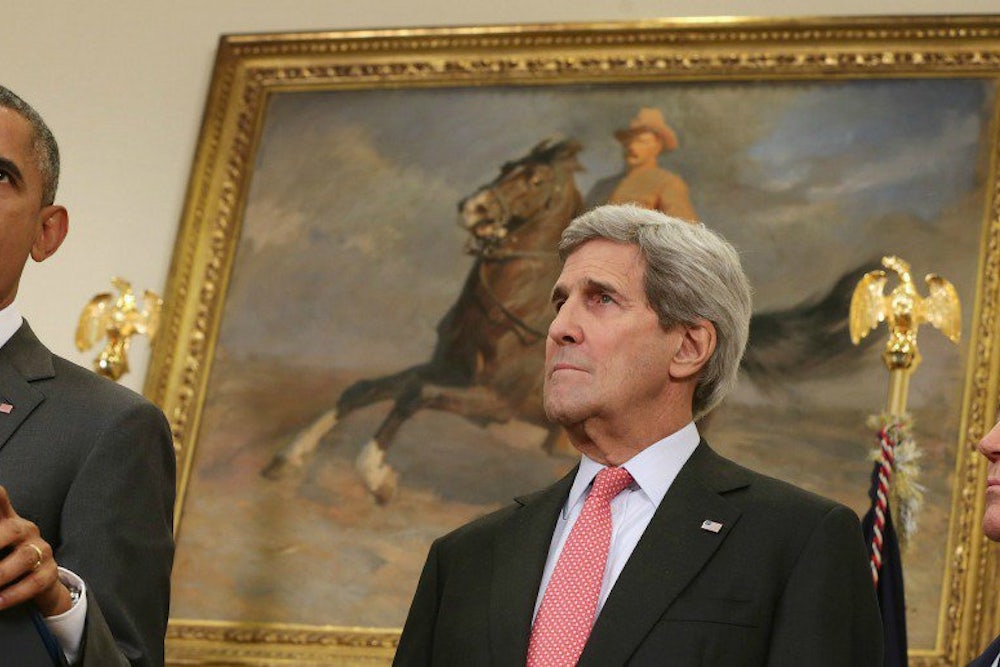“I look forward to engaging Congress and the American people in efforts to refine, and ultimately repeal, the AUMF’s mandate," President Barack Obama said at the National Defense University in May 2013, referring to the 2001 authorization to use military force. "And I will not sign laws designed to expand this mandate further."
It appears only one of those two statements was true.
On Wednesday, Obama submitted a proposal for an AUMF against the Islamic State (ISIS), an expansion of his current powers to wage war granted by the Constitution and previous congressional authorizations. It includes a three year sunset provision and imposes some restrictions on the use of ground forces. The proposal comes six months after the United States started a bombing campaign against the radical militant group, which now controls vast swathes of territory in Syria and Iraq.
While Obama reiterated that he remains “committed to working with the Congress and the American people to refine, and ultimately repeal, the 2001 AUMF,” he is not proposing its repeal, and is indeed seeking to temporarily expand its mandate.
Until now, the president has justified the use of military force against ISIS using three theories. The first relies upon the controversial 2001 AUMF, passed three days after the 9/11 attacks, authorizing the use of force against organizations and persons—and, though it wasn’t included in the original 60-word sentence—against “associated forces” responsible for those atrocities. His second legal justification pointed to the 2002 AUMF passed by Congress to allow for the invasion of Iraq. And the third, invoked when the U.S. began bombing ISIS targets back in August, is Article II of the Constitution, which makes the president commander-in-chief of the U.S. military.
Legal scholars have already pointed out the problems underlying the use of each theory. The 2001 AUMF, broadly written with neither geographical nor temporal limits, and used by the Obama administration to justify its drone campaigns around the world, is widely believed to allow for hostilities against two groups: the Taliban and Al Qaeda. ISIS, after splitting off from Al Qaeda, is neither. Only by stretching the meaning of “associated forces” to include “successor” or “splinter” groups could ISIS be considered a target covered by the 2001 AUMF.
The 2002 AUMF was clearly intended to justify action against the regime of Saddam Hussein, though the language used—which specified only the “continuing threat posed by Iraq”—is, like the 2001 AUMF, rather vague. But as ISIS was created after the U.S. invasion, it would be difficult to consider the danger they pose as somehow a continuation of the ostensible threat of Hussein’s Iraq.
And Article II powers can only be used for 60 days before Congress, who has the Constitutional authority to declare war, must be consulted. That window closed in October 2014.
Despite the fact that the war against ISIS has already been underway for half a year, the administration is just now seeking congressional input. Obama believes he already has had the authority for military action, and sees this as a chance to “engage Congress.” With this proposal, the president is seeking the power to place forces in Iraq, though banning engagement in “enduring offensive ground combat operations.” No geographical limitations are set. While the 2001 AUMF did not mandate congressional reporting regarding the progress of military operations, this new proposal requires Congress to be informed of “specific actions taken pursuant to this authorization” in classified briefings. The new AUMF would sunset the 2002 AUMF authorizing force against Hussein’s regime.
Critics of the president’s proposal have pointed out that, like the 2001 AUMF, the language of this new authorization is vague. The White Press Secretary Josh Earnest admitted the the language was “intentionally” fuzzy so as to avoid “burdensome constraints” on the president who needs “flexibility” to prosecute the war. This is troubling to many observers.
Zak Newman of the ACLU says that the text “does not identify the objective for the use of that force.” Besides the intention to “degrade and defeat” ISIS, there is no clear indication of what a successful operation would look like. And while “associated forces” is slightly more narrowly defined in this proposal, the “closely-related successor entities” to ISIS is still rather broad. Newman proposes the inclusion of “a requirement that individuals or organizations should be under the operational command and control of ISIS.” The chairman of the Senate Foreign Relations Committee, Democratic Senator Robert Menendez, pointed out Wednesday that the definition of “enduring” remains unclear. It appears to be an attempt to find a middle ground between more hawkish members of Congress who want no limits on ground forces and those who want no boots on the ground.
The larger problem with Obama’s proposal is that it leaves the 2001 statute untouched. As Stephen Vladeck wrote, this “not only renders an ISIL-specific bill largely beside the point, but it does nothing to end the ‘forever war’ or solve any of the well-established oversight and accountability problems with U.S. war powers today.” Harold Koh, who served as a legal advisor to the State Department in the Obama administration between 2009-2013, is critical of the way the law has been used and is in favor of repealing it, saying Wednesday that the “2001 AUMF has been in existence for many years and is increasingly construed to cover groups that didn’t even exist as of 9/11.”
Obama may have decided not to sunset the 2001 AUMF to gain the support of Republicans in both chambers. The GOP is hesitant to place any restrictions on the executive authority to battle ISIS, as such a sunset would potentially limit the authorities of a future Republican president to wage war. Meanwhile, many Democrats want more restrictions in the AUMF to address the seemingly endless nature of the war against terrorist groups. Now that Obama’s proposal has been submitted, it will almost certainly undergo revisions to gain enough support from both parties.
